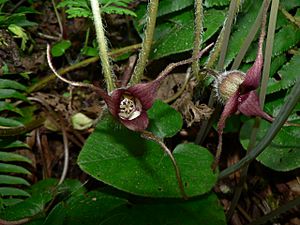British Columbia wild ginger facts for kids
Quick facts for kids British Columbia wild ginger |
|
|---|---|
 |
|
| Conservation status | |
| Scientific classification | |
| Genus: |
Asarum
|
| Species: |
caudatum
|
| Synonyms | |
|
|
Asarum caudatum is a plant also known as British Columbia wild ginger, western wild ginger, or long-tailed wild ginger. It grows naturally in wet, rich forests across western North America. You can find it from British Columbia down to California and as far east as western Montana.
This plant stays green all year. Its flowers bloom from March to August. The flowers are special: they are hairy, shaped like a cup, and can be brown-purple or green-yellow. They end in three long, curved parts, which are often hidden by the leaves. The plant has long underground stems called rhizomes. These rhizomes help the plant spread and form big patches of kidney-shaped leaves. If you rub the leaves, they smell like ginger!
Contents
What's in a Name?
The name Caudatum comes from the Latin word cauda, which means "tail." This name was chosen because the flower's outer parts, called the calyx, look like little tails.
Where It Grows and How It Lives
You can find Asarum caudatum in places like British Columbia, Washington, Oregon, Northern California, Idaho, and Montana. It likes moist, shady spots. This plant is often found growing under taller trees in mixed conifer forests that are below 2,200 feet in height. It's often one of the most common plants in these areas.
A. caudatum can spread in two main ways. It mostly spreads using its rhizomes, which are underground stems. This means one plant can create many patches of itself, all connected underground. It can also make seeds. Ants help spread these seeds. The flowers are pollinated by flies.
Ants are attracted to a fatty part attached to the seed. They carry the whole seed package back to their colonies. But once the ant realizes only the fatty part is tasty, it often drops the seed outside the nest. Making seeds with this special fatty part takes a lot of energy for the plant. So, it's usually easier for the plant to just spread using its underground stems.
How People Use It
The root of A. caudatum can be eaten. Native American people used this plant for different kinds of medicine.
Some people use A. caudatum as a substitute for regular ginger. They also make a tea from it, believing it has medicinal benefits. However, some plants in the family Aristolochiaceae (which A. caudatum belongs to) contain a substance called aristolochic acid. Scientists are careful about using plants with this acid because it can be harmful. On a different note, studies have shown that A. caudatum has properties that can fight certain fungi.
Is It Endangered?
Asarum caudatum is not currently considered an endangered species. However, the natural places where it grows are sometimes threatened by things like logging and other human activities.
See also
 In Spanish: Asarum caudatum para niños
In Spanish: Asarum caudatum para niños


